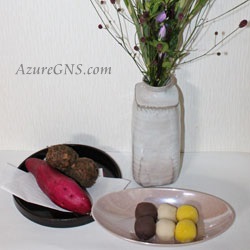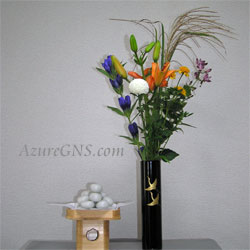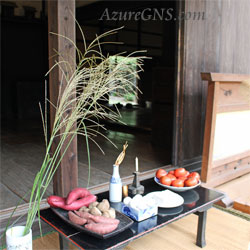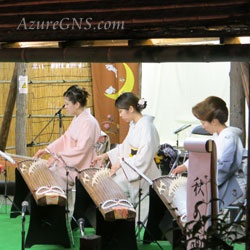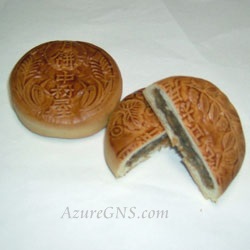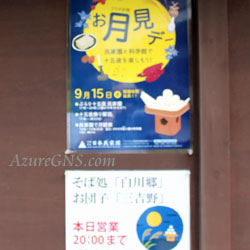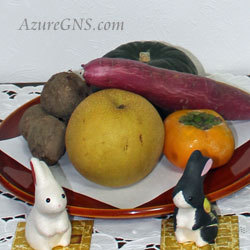(9月または10月の満月の夜)
O-tsuki-mi;
Moon Viewing
(on a night of the full moon in September or October)
●お月見 O-tsuki-mi; moon viewing
●十五夜 Jugo-ya; Moon Viewing Night
●月 moon
●仲秋の名月 Chushu-no-meigetsu; harvest moon
●満月 a full moon
●半月 a half moon
●三日月 crescent (moon); new moon
(月 moon には定冠詞の the を使いますが、half moon、crescent moon、beautiful moon など形容詞が前にくると、不定冠詞のaまたはanを一般に使います。)
●月明かり moonlight
●旧暦 lunar calendar; old calendar
●祈り prayer
●供える (to) offer
●すすき Japanese pampas grass
●(月見)団子 (moon viewing) dumpling
●作物;収穫物 crop(s) (しばしば複数形で使います。)
●里芋 Japanese taro
●さつま芋 sweet potato; yam
●栗 chestnut
●うさぎ rabbit
◆秋になると空が澄み、月が特に美しく見えます。
In autumn, the air is clear, and the moon looks especially beautiful.
◆人々は十五夜に満月を見て楽しみます。
People enjoy gazing at the full moon on Moon Viewing Night, or Jugo-ya.
◆元々、月見は旧暦の8月15日の夜に行われていました。
Originally, O-tsuki-mi was held on the night of August 15th according to the lunar calendar.
◆現在、十五夜は9月または10月の夜で、日付は年によって異なります。
Recently, Jugo-ya is celebrated on a night in September or October and the date depends on the year.
◆秋分の日(9月22日か23日)の前後約1ヶ月内の満月の夜です。
It falls on a night of a full moon 15 days before or after Shubun-no-hi, Autumn Equinox Day (September 22nd or 23rd).
◆月見団子と呼ばれる特別な団子を月にお供えします。
Special dumplings called tsuki-mi-dango are offered to the moon.
◆これらの団子の材料、形、大きさ、数は地方によってさまざまです。
The ingredients, shapes, sizes of the dumplings and the number of the dumplings offered, depend on the region.
◆新しく収穫した果物や作物も月にお供えされます。
Newly harvested fruits and other foods from the year’s harvest are also offered to the moon.
◆一般的に里芋、さつま芋、栗、柿などがお供えに使われます。
Popular examples of such offerings include taros, sweet potatoes, chestnuts and persimmons.
◆秋を代表する植物で、稲穂に似て、魔除けになると言われているすすきも飾ります。
Japanese pampas grass, a typical autumn plant, are also added for decoration because they look like ears of rice and are said to be a form of protection from evil spirits.
◆十五夜を祝う風習は地方や世代によって異なります。
The way Jugo-ya is celebrated varies between regions and generations.
◆京都市の渡月橋や大覚寺の大沢池、奈良市の興福寺の猿沢の池、宮城県の松島、滋賀県彦根市の玄宮園など観月の名所が数多くあります。
There are many famous places for O-tsuki-mi: Togetsu-kyo Bridge and Osawa Pond of Daikaku-ji Temple in Kyoto City, Sarusawa Pond of Kofuku-ji Temple in Nara City, Matsushima in Miyagi Prefecture and Gengu-en Garden in Hikone City, Shiga Prefecture.
◆日本の各地で観月の会が開かれ、古式ゆかしい舞楽が奉納されたり、コンサート、茶会、句会などが開かれたりします。
O-tsuki-mi are held throughout Japan with various events such as ancient traditional court dances and music, concerts, tea ceremonies and gatherings of Haiku (17-syllable short poem written in a 5-7-5 pattern).
◆お月見は豊かな収穫への祈りの気持ちも込められています。
O-tsuki-mi may also include a prayer to the moon for a plentiful harvest.
◆お月見の起源はよく分っていませんが、中国から伝わったと言われています。
The origin of O-tsuki-mi is not certain, but it was probably introduced to Japan from China.
◆中国では旧暦の8月15日の中秋節に月見団子ではなく月餅を食べます。
In China, people eat geppei instead of moon dumplings during Chushu-setsu (the Mid-Autumn Festival) on August 15th by the lunar calendar.
◆月餅は餡、木の実、胡麻、干し柿、アヒルの卵などが入った平たい円形の焼き菓子です。
Geppei is a flat and round cake containing anko (or an), nuts, sesame, dried persimmons, duck eggs and other ingredients.
◆餡の種類は豊富で、粒餡、漉餡、黄身餡、蓮の実餡、胡麻餡などがあります。
There are many types of anko: tsubu-an (coarse sweet red bean paste), koshi-an (strained sweet red bean paste), kimi-an (strained sweet white kidney bean and egg yolk paste) and hasu-no-mi-an (strained sweet lotus seed paste) and goma-an (sweet sesame paste).
◆月餅の起源は中秋節の月神様へのお供えものでしたが、現在はこの時期に月餅を親しい人やお世話になっている人に贈る習慣があります。
The origin of geppei is an offering to the god of the moon during Chushu-setsu, but nowadays Chinese send geppei as a gift to people who are close to them or take care of them at this time of the year.
◆日本では月で兎が「杵」と「臼」を使って餅をついているという言い伝えがあります。
In Japan, it is said that there is a rabbit on the moon pounding steamed rice with “kine” (a wooden mallet) in “usu” (a big mortar for rice cake) to make mochi.
◆これは日本人が、月のクレーターを兎が餅をついているように見えると思ったからです。
This is because Japanese thought that the craters of the moon looked like a rabbit making rice cakes.
(より詳しい情報は「我が家のお月見」をご覧下さい。)
(Please see “Our Moon Viewing Experience” for further information.)
Copyright (C) Azure Global Network Services. All Rights Reserved.
